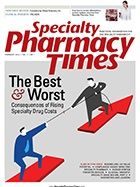Publication
Article
Specialty Pharmacy Times
The Best and Worst Consequences of Rising Specialty Drug Costs
Author(s):
Specialty pharmacies could serve as the primary conduit to generate value from at-risk agreements between manufacturers and providers.
THE METEORIC RISE IN THE COST of specialty drugs has been well-documented and appropriately lambasted, at least in some circumstances. According to a recent report by the Kaiser Family Foundation and Truven Health Analytics, prescription drug spending accounts for 10% of national spending on health at approximately $300 billion.
Moreover, drug spending in employer health plans is nearly double that share at 19%.1 Two consequences of the growing cost for specialty medications percolated to the top of my list when considering its ability to impact the specialty pharmaceutical industry.
First is the arrival of the pharmaceutical manufacturers’ day at-risk.
Pharma’s Day At-Risk is a Good Thing
In November 2015, pharma’s at-risk day in the United States arrived with the announcement of the deal between Harvard Pilgrim and Amgen for the PCSK9 inhibitor, Repatha. The gist of the agreement is that Harvard Pilgrim will recoup additional rebates from Amgen if various patient groups taking Repatha do not achieve specific cholesterol targets.
Given the need for improved alignment within the industry as a whole (manufacturers, payers, providers, and patients), this development is a good thing. If manufacturers and payers would allow them to do so, specialty pharmacies could serve as the primary conduit, or arbiters if you will, that enable both parties to generate value from at-risk agreements.
Now we will explore how this can be achieved.
1. Leverage programs proven to improve adherence
Just because prescriptions are being filled does not mean patients are actually taking their medications or taking them properly. Patients need a greater level of support to remain adherent to their medication regimens.
Pharmacists and patient care coordinators employed by medication management providers and specialty pharmacies are perfectly suited for this task. A study published in 2012 by Curant Health CEO Patrick Dunham and others demonstrated that for a population of patients taking highly active antiretroviral therapy (HAART), medication adherence increased 28% over baseline.
By a second measure, there was a 69% jump in patients who were at least 95% adherent to all medications. The 95% threshold represents the commonly applied definition of an acceptable HAART adherence level.
The percentage of patients whose viral loads were considered undetectable increased from 28% to 66% with medication therapy management.2
2. Agree on data and outcomes
In order for manufacturers to accept some risk, there should be upfront agreement on financial and health outcomes. Top health outcomes should be close to the clinical trial results manufacturers tout themselves.
For example, cure rates of 96% to 99% for hepatitis C patients who had no prior treatment for a $94,500, 12-week course of Harvoni. For gastrointestinal conditions, indications of remission, including “symptom free” or “side-effect free,” are the intended outcomes that demonstrate value for associated therapies.
For Medicare patients with multiple chronic conditions who are frequently on 10 prescription medications or more, hospital admissions and readmissions data are accessible, high-value outcomes metrics. Agreement on health outcomes for new therapies, including PCSK9 inhibitors, will be more complicated.
However, fewer instances of acute care, including emergency department visits, will almost certainly be a metric that payers and manufacturers should measure closely.
3. Assign a near-neutral third-party for health outcomes metrics arbitration
Neither payers nor manufacturers can be the arbiters of the data by which at-risk agreements are adjudicated. The inherent biases in play necessitate the use of a third party who will aggregate, assess, and validate the data upon which those payment determinations will be made.
In the world of specialty medications, the entity best suited to this task is the specialty pharmacy with validation from a clinical pharmacist. The first reason for this is that the pharmacy works with multiple payers.
The second is that the pharmacist’s pharmacological expertise is critical to mitigating adverse events experienced by patients during therapy; this helps reduce abandonment and improve adherence.
However, the pharmacy is not completely neutral either, with payer requirements causing specialty pharmacies to become more synchronized. We believe the most streamlined, applicable data reside with specialty pharmacies and medication therapy management providers whose programs are proven to improve adherence and outcomes.
Most importantly, pharmacists are in the best position to acquire data points outside of the prescriber’s office, thanks to more candid self-reporting directly from the patient. Our pharmacists regularly discover data, directly from patients, of which other members of the care team were previously unaware.
These data can include lifestyle preferences, financial hardship, medication side effects, and other potential barriers to adherence.
Barriers to Access are not Good and Must be Broken Down
The second consequence applies to health care on a national level, but the pharmaceutical industry, inclusive of pharmacy benefit managers (PBMs) and payers, has the ability to do something about it.
The barriers to treatment access, even preventative treatment, created by increasingly complex prior authorization processes and state budgets stretched to the breaking point, are causing patients to defer treatment. This is not good.
According to evidence presented at the Liver Meeting 2015 in November, Medicaid denial for hepatitis C drugs is nearing 50% in some states.
“The finding confirms anecdotal reports from physicians in the United States that they are unable to provide these lifesaving medications to some of their most impoverished patients,” Vincent Lo Re, MD, assistant professor of medicine, biostatistics, and epidemiology at the University of Pennsylvania in Philadelphia, told Medscape Medical News in a November 2015 article.3
The American Association for the Study of Liver Diseases describes the highest priority patients in its care stratification for those seeking treatment for chronic hepatitis C infection as those at “F3 or higher by biopsy or FIB-4 score greater than or equal to 2.5 and less than F3 with chronic kidney disease.”4
Yet Medicaid treatment criteria in Delaware, for example, require, “Metavir greater than or equal to F4 based on biopsy or documented cirrhosis through ultrasound or CT scan with extrahepatic manifestations, or clinical findings, such as the presence of ascites.”5
Despite the success of the Affordable Care Act in achieving its intended goal to increase the number of insured Americans, it also had an unintended consequence that created a bottleneck of patients awaiting authorization for the exact therapies, or actual cures, for which payers previously clamored.
Some of these patients have their prescriptions authorized and filled, only to learn that refills of Harvoni run into a monthly prior authorization barrier from their PBM or payer. At the risk of failing to adhere to the costly, but valuable regimen due to this barrier, the patient may well develop resistance to the therapy.
We are learning that new curative therapies, for which payers were asking not long ago, cannot be treated the same way as beta blockers for high blood pressure and hypertension.
Investing in Access Solutions
Rather than curse the darkness, we are making investments in new personnel specifically tasked with prior authorization assistance. These new hires will carry an arsenal of knowledge and experience that makes them the most suitable resource given the increasingly complex requirements for successful completion of prior authorization forms.
It is appropriate that we make this investment because the pharmacy is compensated by the fulfillment of prescriptions. It is also appropriate because at Curant Health, we believe that without access to appropriately prescribed specialty medications, health outcomes suffer.
The new class of “prior authorization pharmacists” must possess a clinical skill set that accommodates a heavy clinical burden with administrative tasks wrapped in.
This position necessitates an advanced degree in pharmacy, clinical experience, and the ability to act as an information resource on medication therapy and drug-related information for patients, physicians, and other health care professionals.
These prior authorization pharmacists must be able to apply sound clinical judgement to a variety of situations and second level appeals. This person must be patient, meticulous, and tenacious, with the knowledge of how important securing medication payment approval is to each patient.
Our medication therapy management pharmacists need to focus on the provision of clinical care, not the administration of complex prior authorizations. Retail pharmacists generally don’t possess the requisite clinical expertise, and most pharmacy technicians are simply not skilled enough for the task.
Clinicians, including the physicians and nurses, to whom many prior authorization tasks fall, need to be focused on clinical care as well, and not this additional administrative burden. But someone has to do it, and prior authorizations aren’t going away.
So the onus for identifying and cultivating a new class of pharmacists charged specifically with clearing prior authorizations for specialty medications falls on the pharmacy.
Commitment to Defining Value as Outcomes Divided by Costs
While the manufacturers and payers, including Medicare and Medicaid, continue to grapple with the consequences of rising specialty drug costs, we will continue to fight for access to therapies on behalf of our patients and their providers.
As we further define value in health care as outcomes divided by costs, we will always improve patient education and adherence to specialty regimens, especially for those who need it most: those with multiple chronic conditions.
We do that every day because we know, with great certainty, that it improves patient outcomes and reduces overall health care costs. SPTReferences
- http://kff.org/health-costs/poll-finding/kaiser-health-tracking-poll-june-2015/
- Dunham, P and Karkula, J. “Effects of a Pharmacy-Care Program on Adherence and Outcomes.” The American Journal of Pharmacy Benefits, January / February 2012. https://www.curanthealth.com/wp-content/uploads/2014/03/Effects-of-a-Pharmacy-Care-Program-on-Adherence-and-Outcomes.pdf
- http://www.medscape.com/viewarticle/854708
- Xu F, et al. AASLD The Liver Meeting 2014, Boston, MA. LB-29.
- Center for Evidence-based Policy. (2015b). State Medicaid Coverage Policies for Harvoni and Viekira Pak Treatment of Hepatitis C. Portland, OR: Center for Evidence-based Policy, Oregon Health & Science University. https://www.ohsu.edu/xd/research/centers-institutes/evidence-based-policy-center/evidence/med/upload/02b-HCV-Medicaid-Policy-SenFin-2015.pdf

MARC O’CONNOR is chief operating officer for Curant Health. Curant Health treats patients nationwide through its medication management protocols, including medication reconciliation and establishment of personalized medication regimens, and supports its provider partners and care coordination with its award-winning electronic health record, MedPlan. Curant’s health care professionals provide individualized care proven to improve the lives and reduce the overall health care costs of chronically ill patients.







